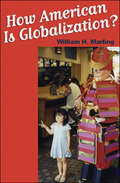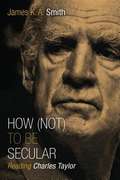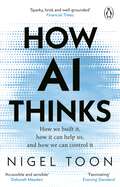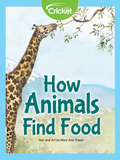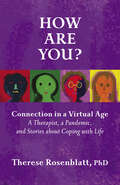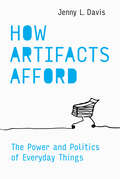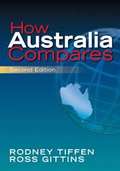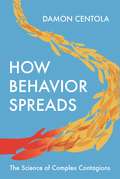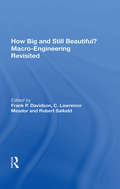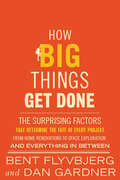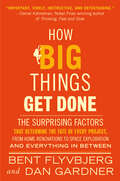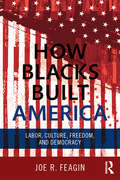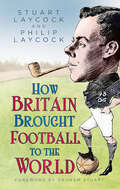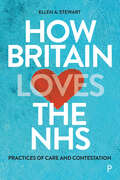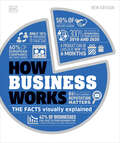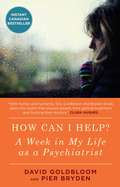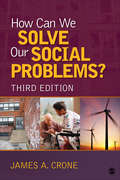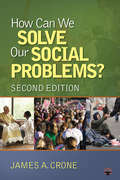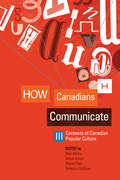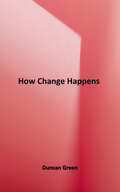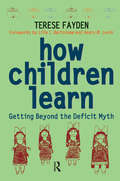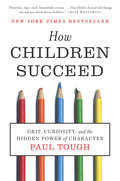- Table View
- List View
How "American" Is Globalization?
by William H. MarlingWilliam Marling's provocative work analyzes—in specific terms—the impacts of American technology and culture on foreign societies. Marling answers his own question—how "American" is globalization?—with two seemingly contradictory answers: "less than you think" and "more than you know." Deconstructing the myth of global Americanization, he argues that despite the typically American belief that the United States dominates foreign countries, the practical effects of "Americanization" amount to less than one might suppose. Critics point to the uneven popularity of McDonalds as a prime example of globalization and supposed American hegemony in the world. But Marling shows, in a series of case studies, that local cultures are intrinsically resilient and that local languages, eating habits, land use, education systems, and other social patterns determine the extent to which American culture is imported and adapted to native needs. He argues that globalization can actually accentuate local cultures, which often put their own imprint on what they import—from translating films and television into hundreds of languages to changing the menu at a McDonalds to include the Japanese favorite Chicken Tastuta.Marling also examines the unexpected ways in which American technology travels abroad: the technological transferability of the ATM, the practice of franchising, and "shop-floor" American innovations like shipping containers, bar codes, and computers. These technologies convey American attitudes about work, leisure, convenience, credit, and travel, but as Marling shows, they take root overseas in ways that are anything but "American."
How (Not) To Be Secular: Reading Charles Taylor
by James K. A. SmithWhat does it mean to say we live in a secular world? Charles Taylor's landmark book A Secular Age (2007) provides a monumental history and analysis of what it means for us to live in our post- Christian present - a pluralist world of competing beliefs and growing unbelief. This book by Jamie Smith is a compact field guide to Taylor's genealogy of the secular, making that 900-page work accessible to a wide array of readers. Smith's How (Not) to Be Secular is also, however, a philosophical guidebook for practitioners - a kind of how-to manual that ultimately offers guidance on how to live in a secular age. It's an adventure in self-understanding and a way to get our bearings in postmodernity. Whether one is proclaiming faith to the secularized or is puzzled that there continue to be people of faith in this day and age, this book is a philosophical story meant to help us locate where we are and what's at stake.
How AI Thinks: How we built it, how it can help us, and how we can control it
by Nigel ToonTHE #2 TIMES BESTSELLER'Artificial intelligence is going to have a massive impact on everyone’s lives... an accessible and sensible read that helps demystify AI' Deborah Meaden, entrepreneur and star of Dragon's Den'Nigel Toon is a visionary leader in the field of artificial intelligence... a must-read' Marc Tremblay, Distinguished Engineer, MicrosoftThose who understand how AI thinks are about to win big.We are used to thinking of computers as being a step up from calculators - very good at storing information, and maybe even at playing a logical game like chess. But up to now they haven't been able to think in ways that are intuitive, or respond to questions as a human might. All that has changed, dramatically, in the past few years.Our search engines are becoming answer engines. Artificial intelligence is already revolutionising sectors from education to healthcare to the creative arts. But how does an AI understand sentiment or context? How does it play and win games that have an almost infinite number of moves? And how can we work with AI to produce insights and innovations that are beyond human capacity, from writing code in an instant to unfolding the elaborate 3D puzzles of proteins?We stand at the brink of a historic change that will disrupt society and at the same time create enormous opportunities for those who understand how AI thinks. Nigel Toon shows how we train AI to train itself, so that it can paint images that have never existed before or converse in any language. In doing so he reveals the strange and fascinating ways that humans think, too, as we learn how to live in a world shared by machine intelligences of our own creation.
How America Eats: A Social History of U. S. Food and Culture (American Ways)
by Jennifer Jensen Wallach<p><i>How America Eats: A Social History of U.S. Food and Culture</i>, by food and social historian Jennifer Wallach, sheds a new and interesting light on American history by way of the dinner table. It is, at once, a study of America's diverse culinary history and a look at the country's unique and unprecedented journey to the present day. While undeniably a "melting pot" of different cultures and cuisines, America's food habits have been shaped as much by technological innovations and industrial progress as by the intermingling and mixture of ethnic cultures. By studying what Americans have been eating since the colonial era, we are further enlightened to the conflicting ways in which Americans have chosen to define themselves, their culture, their beliefs, and the changes those definitions have undergone over time. <p>Understanding the American diet is the first step toward grasping the larger truths, the complex American narratives that have long been swept under the table, and the evolving answers to the question: What does it mean to be American?
How Animals Find Food
by Mary Ann FraserAnimals get their energy from the food they eat. Animals depend on other living things for food. Some animals, called herbivores, eat plants; while others are carnivores that eat other animals. Scavengers, like vultures and hyenas, eat dead animals. Learn how different animals eat and how this determines how they look and where they live. Can you name other animals that are scavengers?
How Are You?: A Therapist, A Pandemic, and Stories about Coping with Life
by Dr. Therese RosenblattA therapist shares her patients&’ experiences—and her own—during the dramatic disruption of the Covid crisis. By turns a memoir, a chronicle, and a provocative contemplation of life in a socially distanced and virtual world, How Are You? tells the story of a therapist plunged overnight into the unsettling reality of a pandemic and all-virtual therapy. Therese Rosenblatt shares her privileged front-row seat into the hearts and minds of her patients, to report on what has gone on inside real peoples&’ heads from the dark, early days of the pandemic through its long, drawn-out progression. Dr. Rosenblatt then trains her attuned eyes and ears onto herself, sharing some of her experiences and challenges—and unexpected pleasures—as she navigates this new world together with her patients. In addition to recounting how her patients are coping with loss, loneliness, and isolation, as well as overcrowding with relatives, spouses, and partners and challenges with substance use, she opens a window into her private thoughts as she conducts her sessions. All the while, she contemplates the specter of catastrophic illness and the move to an existence liberated from the physical space of the consulting room, yet missing its comforts and human sensibilities. Whether addressing difficult marriages, ambivalence about pregnancy, or young adults trying to launch into the world while locked down with their parents, Dr. Rosenblatt offers insight gleaned from twenty-six years of practice—and explores in depth this historic event&’s psychological effects on us as individuals.
How Artifacts Afford: The Power and Politics of Everyday Things (Design Thinking, Design Theory)
by Jenny L. DavisA conceptual update of affordance theory that introduces the mechanisms and conditions framework, providing a vocabulary and critical perspective. Technological affordances mediate between the features of a technology and the outcomes of engagement with that technology. The concept of affordances, which migrated from psychology to design with Donald Norman's influential 1988 book, The Design of Everyday Things, offers a useful analytical tool in technology studies--but, Jenny Davis argues in How Artifacts Afford, it is in need of a conceptual update. Davis provides just such an update, introducing the mechanisms and conditions framework, which offers both a vocabulary and necessary critical perspective for affordance analyses.
How Australia Compares
by Rodney Tiffen Ross GittinsHow Australia Compares is a handy reference that compares Australia with 17 other developed countries across a wide range of social, economic and political dimensions. Whenever possible, it gives not only snapshot comparisons from the present, but charts trends over recent decades or even longer. Encyclopaedic in scope, it provides statistics for a huge range of human activity, from taxation to traffic accidents, homicide rates to health expenditure, interest rates to internet usage. This new edition is fully revised and updated, and features two new chapters: The Howard Impact and The Search for Scoreboards. New sections include obesity, advertising, broadband internet access, childcare and corruption. Information is highly accessible with double-page spreads for each topic. Tables and graphs are presented on one page, and clear explanation and analysis on the facing page. In each discussion the focus is to put the Australian experience into international perspective, drawing out the implications for the nation's performance, policies and prospects.
How Behavior Spreads: The Science of Complex Contagions (Princeton Analytical Sociology Series #3)
by Damon CentolaA new, counterintuitive theory for how social networks influence the spread of behaviorNew social movements, technologies, and public-health initiatives often struggle to take off, yet many diseases disperse rapidly without issue. Can the lessons learned from the viral diffusion of diseases be used to improve the spread of beneficial behaviors and innovations? In How Behavior Spreads, Damon Centola presents over a decade of original research examining how changes in societal behavior--in voting, health, technology, and finance—occur and the ways social networks can be used to influence how they propagate. Centola's startling findings show that the same conditions accelerating the viral expansion of an epidemic unexpectedly inhibit the spread of behaviors. While it is commonly believed that "weak ties"—long-distance connections linking acquaintances—lead to the quicker spread of behaviors, in fact the exact opposite holds true. Centola demonstrates how the most well-known, intuitive ideas about social networks have caused past diffusion efforts to fail, and how such efforts might succeed in the future. Pioneering the use of Web-based methods to understand how changes in people's social networks alter their behaviors, Centola illustrates the ways in which these insights can be applied to solve countless problems of organizational change, cultural evolution, and social innovation. His findings offer important lessons for public health workers, entrepreneurs, and activists looking to harness networks for social change.Practical and informative, How Behavior Spreads is a must-read for anyone interested in how the theory of social networks can transform our world.
How Big And Still Beautiful?: Macro- Engineering Revisited
by Frank P. DavidsonThis volume examines fundamental issues of macro-engineering—now a planetary norm—from the viewpoints of psychiatry, social science, management, and law. The contributors suggest a general theory to guide future decisions on large-scale projects and programs and analyze specific cases in the context of a set of public-interest guidelines.
How Big Things Get Done: The Surprising Factors That Determine the Fate of Every Project, from Home Renovations to Space Exploration and Everything In Between
by Bent Flyvbjerg Dan GardnerThe secrets to successfully planning and delivering ambitious, complex projects on any scale—from home renovation to space exploration—by the world's leading expert on megaprojects.Nothing is more inspiring than a big vision that becomes a triumphant, new reality. Think of how the Empire State Building went from a sketch to the jewel of New York's skyline in twenty-one months, or how Apple&’s iPod went from a project with a single employee to a product launch in eleven months.These are wonderful stories. But most of the time big visions turn into nightmares. Remember Boston&’s &“Big Dig&”? Almost every sizeable city in the world has such a fiasco in its backyard. In fact, no less than 92% of megaprojects come in over budget or over schedule, or both. The cost of California&’s high-speed rail project soared from $33 billion to $100 billon—and won&’t even go where promised. More modest endeavors, whether launching a small business, organizing a conference, or just finishing a work project on time, also commonly fail. Why?Understanding what distinguishes the triumphs from the failures has been the life&’s work of Oxford professor Bent Flyvbjerg, dubbed &“the world&’s leading megaproject expert.&” In How Big Things Get Done, he identifies the errors in judgment and decision-making that lead projects, both big and small, to fail, and the research-based principles that will make you succeed with yours. For example:Understand your odds. If you don't know them, you won't win.Plan slow, act fast. Getting to the action quick feels right. But it's wrong. Think right to left. Start with your goal, then identify the steps to get there.Find your Lego. Big is best built from small.Be a team maker. You won't succeed without an "us."Master the unknown unknowns. Most think they can't, so they fail. Flyvbjerg shows how you can.Know that your biggest risk is you.Full of vivid examples ranging from the building of the Sydney Opera House, to the making of the latest Pixar blockbusters, to a home renovation in Brooklyn gone awry, How Big Things Get Done reveals how to get any ambitious project done—on time and on budget.
How Big Things Get Done: The Surprising Factors That Determine the Fate of Every Project, from Home Renovations to Space Exploration and Everything In Between
by Bent Flyvbjerg Dan Gardner&“Why do big projects go wrong so often, and are there any lessons you can use when renovating your kitchen? Bent Flyvbjerg is the &‘megaproject&’ expert and Dan Gardner brings the storytelling skills to How Big Things Get Done, with examples ranging from a Jimi Hendrix studio to the Sydney Opera House.&”—Financial Times &“Entertaining . . . There are lessons here for managers of all stripes.&”—The EconomistA BEST BOOK OF THE YEAR: Economist, Financial Times, CEO Magazine, MorningstarFinalist for the Porchlight Business Book Award, the Financial Times and Schroders Business Book of the Year Award, and the Inc. Non-Obvious Book AwardNothing is more inspiring than a big vision that becomes a triumphant, new reality. Think of how the Empire State Building went from a sketch to the jewel of New York&’s skyline in twenty-one months, or how Apple&’s iPod went from a project with a single employee to a product launch in eleven months.These are wonderful stories. But most of the time big visions turn into nightmares. Remember Boston&’s &“Big Dig&”? Almost every sizeable city in the world has such a fiasco in its backyard. In fact, no less than 92% of megaprojects come in over budget or over schedule, or both. The cost of California&’s high-speed rail project soared from $33 billion to $100 billon—and won&’t even go where promised. More modest endeavors, whether launching a small business, organizing a conference, or just finishing a work project on time, also commonly fail. Why?Understanding what distinguishes the triumphs from the failures has been the life&’s work of Oxford professor Bent Flyvbjerg, dubbed &“the world&’s leading megaproject expert.&” In How Big Things Get Done, he identifies the errors in judgment and decision-making that lead projects, both big and small, to fail, and the research-based principles that will make you succeed with yours. For example:• Understand your odds. If you don&’t know them, you won&’t win.• Plan slow, act fast. Getting to the action quick feels right. But it&’s wrong. • Think right to left. Start with your goal, then identify the steps to get there.• Find your Lego. Big is best built from small.• Be a team maker. You won&’t succeed without an &“us.&”• Master the unknown unknowns. Most think they can&’t, so they fail. Flyvbjerg shows how you can.• Know that your biggest risk is you.Full of vivid examples ranging from the building of the Sydney Opera House, to the making of the latest Pixar blockbusters, to a home renovation in Brooklyn gone awry, How Big Things Get Done reveals how to get any ambitious project done—on time and on budget.
How Blacks Built America: Labor, Culture, Freedom, and Democracy
by Joe R. FeaginHow Blacks Built America examines the many positive and dramatic contributions made by African Americans to this country over its long history. Almost all public and scholarly discussion of African Americans accenting their distinctive societal position, especially discussion outside black communities, has emphasized either stereotypically negative features or the negative socioeconomic conditions that they have long faced because of systemic racism. In contrast, Feagin reveals that African Americans have long been an extraordinarily important asset for this country. Without their essential contributions, indeed, there probably would not have been a United States. This is an ideal addition to courses race and ethnicity courses.
How Britain Brought Football to the World
by Stuart Laycock Philip Laycock'Delighted to learn from this very enjoyable new book that the first ever game of football played in Austria was won by the Vienna Cricket Club.' - Tom Holland, Historian and BroadcasterHave we matched Wembley 1966 and 2022, or lost again on penalties? As a football fan in the Home Nations, there is at least one thing of which you can be sure. Even if sometimes other countries play it better than us, they’ll forever have to thank Britain for the fun, the excitement, the tragedy, the triumph, the pain, the pleasure and the sheer gloriousness of the best sport in the world.From Afghanistan to Zimbabwe, it was Britain that first spread the beautiful game across the world. Cornish miners took football skills along with their pasties to Mexico; Iraqi football legend Ammo Baba learnt the game at an RAF base; the Buenos Aires Cricket Club gave the world Argentine football; and Romanian dentist Iuliu Weiner got not one an English education but a passion for football too.This is a book about football, yes, but it is also a book about all the countries of the world, about shared passion and shared humanity. It’s How Britain Brought Football to the World.
How Britain Loves the NHS: Practices of Care and Contestation
by Ellen A. StewartEPDF and EPUB available Open Access under CC-BY-NC-ND licence. What does it mean to love a healthcare system? It is often claimed that the UK population is unusually attached to its National Health Service, and the last decade has seen increasingly visible displays of gratitude and love. While social surveys of public attitudes measure how much Britain loves the NHS, this book mobilises new empirical research to ask how Britain loves its NHS. The answer delves into a series of public practices – such as campaigning, donating and volunteering within NHS organisations – and investigates how attitudes to the NHS shape patient experience of healthcare. Stewart argues that these should be understood as practices of care for, and contestation about the future of, the healthcare system. This book offers a timely critique of both the potential, and the dysfunctions, of Britain’s complex love affair with the NHS.
How Business Works (DK How Stuff Works)
by DKLearn the essentials of business, finance, and company management with this unique graphic guide from DK!If you're perplexed by profit margins, confused by cash flow, or baffled by balance sheets, all your questions and many more are answered in this indispensable business book. Get to grips with how companies work, from research and development, to sales and marketing, and production and distribution.Eye-catching visual aids give a helpful representation of each and every aspect of business, while complex subjects are broken down into concise explanations, expressed in easy-to-understand language. Crammed with essential terms and key concepts, How Business Works is perfect for anyone looking to take their business to the next level, or those learning the ropes from the ground to the top.Within this one-stop guide you will find:-Hundreds of colorful images and engaging graphics.-Demystifying explanations of complex theories and financial jargon.-Up-to-date guidance on remote and flexible business strategies.-Comprehensive information about international business practice, equipping you with the skills to tackle the global marketplace.Whether you're launching a startup, having trouble managing stakeholder relationships, or simply interested in all things business, you wont find a more comprehensive guide than this! Much more than a standard business management or self help book, How Business Works shows you what other titles only tell you, combining solid reference with no-nonsense advice.Having trouble adjusting to our working from home business culture? This new and improved edition includes the latest tips and techniques to help you stay motivated and achieve the best possible results while working remotely.Reach new heights of personal development!Take your learning to the next level with How Management Works and How to Start Your Own Business - the perfect learning companions to accompany this practical business reference book. Want to stretch your brain even further? Discover DK's extremely successful How ... works series, a curated collection of more than a dozen graphic reference books covering topics from psychology, to technology and music, and many more!
How Can I Help?: A Week in My Life as a Psychiatrist
by David Goldbloom Pier Bryden, M.D.A humane behind-the-scenes account of a week in the life of a psychiatrist at one of Canada’s leading mental health hospitals. How Can I Help? takes us to the frontlines of modern psychiatric care.How Can I Help? portrays a week in the life of Dr. David Goldbloom as he treats patients, communicates with families, and trains staff at CAMH, the largest psychiatric facility in Canada. This highly readable and touching behind-the-scenes account of his daily encounters with a wide range of psychiatric concerns—from his own patients and their families to Emergency Department arrivals—puts a human face on an often misunderstood area of medical expertise. From schizophrenia and borderline personality disorder to post-traumatic stress syndrome and autism, How Can I Help? investigates a range of mental issues. What is it like to work as a psychiatrist now? What are the rewards and challenges? What is the impact of the suffering—and the recovery—of people with mental illness on families and the clinicians who treat them? What does the future hold for psychiatric care? How Can I Help? demystifies a profession that has undergone profound change over the past twenty-five years, a profession that is often misunderstood by the public and the media, and even by doctors themselves. It offers a compassionate, realistic picture of a branch of medicine that is entering a new phase, as increasingly we are able to decode the mysteries of the brain and offer new hope for sufferers of mental illness.
How Can We Solve Our Social Problems?
by James A. CroneMany of today’s social problems—poverty, crime, racism, sexism, drug abuse, unequal access to quality health care or education, threats to the environment, over-population—can seem intractable. James A. Crone’s How Can We Solve Our Social Problems?, Third Edition is designed to give students studying these types of social problems a sense of hope. Unlike the standard survey texts that focus heavily on the causes and consequences of problems, this book is devoted to analyzing possible solutions. It maintains a sense of sociological objectivity throughout, and without moralizing, describes what could be done in America and on a global scale, through government policies, private sector initiatives, and the collective actions of citizens, to address even our most pervasive social problems.
How Can We Solve Our Social Problems?
by James A. CroneMany of today’s social problems—poverty, crime, racism, sexism, drug abuse, unequal access to quality health care or education, threats to the environment, over-population—can seem intractable. James A. Crone’s How Can We Solve Our Social Problems?, Third Edition is designed to give students studying these types of social problems a sense of hope. Unlike the standard survey texts that focus heavily on the causes and consequences of problems, this book is devoted to analyzing possible solutions. It maintains a sense of sociological objectivity throughout, and without moralizing, describes what could be done in America and on a global scale, through government policies, private sector initiatives, and the collective actions of citizens, to address even our most pervasive social problems.
How Can We Solve Our Social Problems?: Dolgon: Social Problems + Crone: How Can We Solve Our Social Problems? 2e
by James A. CroneUpdated with recent issues such as the national debate on health care reform, this Second Edition of How Can We Solve Our Social Problems? gives students a sense of hope by demonstrating specific, realistic steps we can take to solve some of the most pervasive social problems in America today. Author James Crone maintains a sense of sociological objectivity throughout and helps students realize that we can take steps to solve such key social problems as poverty, racial and ethnic inequality, unequal education, and environmental issues. The book's first two chapters define "social problem,," provide a theoretical background, discuss the daunting barriers we face in attempting to solve social problems, and demonstrate how sociology can help.
How Canadians Communicate III
by Bart Beaty Derek Briton Gloria FilaxContexts of Canadian Popular Culture
How Canadians Communicate V: Sports
by David Taras Christopher WaddellFewer Canadians than ever are lacing up skates, swimming lengths at the pool, practicing their curve ball, and experiencing the thrill of competition. However, despite a decline in active participation, Canadians spend enormous amounts of time and money on sports, as fans and followers of sporting events and sports culture. Never has media coverage of sports been more exhaustive, and never has it been more driven by commercial interests and the need to fuel consumerism, on which corporate profits depend. But the power plays now occurring in the arena of sports are by no means solely a matter of money. At issue as well in the media capture of sports are the values that inform our daily lives, the physical and emotional health of the population, and the symbols so long central to a sense of Canadian identity. Writing from a variety of perspectives, the contributors to this collection set out to explore the impact of the media on our reception of, and attitudes toward, sports—to unpack the meanings that sports have for us as citizens and consumers. Some contributors probe the function of sports as spectacle—the escalation of violence, controversies over drug use, and the media’s coverage of tragic deaths—while others shed light on the way in which the media serve to transform sports into a vehicle for the expression of identity and nationalism. The goal is not to score points but to prompt critical discussion of why sports matter in Canadian life and culture and how they contribute to the construction of identity.
How Change Happens
by Duncan GreenSociety is full of would-be 'change agents'-campaigners, government officials, enlightened business people, engaged intellectuals-set on improving public services, reforming laws and regulations, guaranteeing human rights, achieving a fairer deal for those on the sharp end, and greater recognition for any number of issues. Drawing on many first-hand examples and numerous new case studies and interviews with grassroots activists and organizations around the world, as well as Oxfam's unrivaled global experience, this important book answers the question: how does change happen and how can governments, organizations, businesses, leaders, campaigners, employees, and ordinary citizens-make a difference?
How Children Learn: Getting Beyond the Deficit Myth (Series in Critical Narrative)
by Terese FaydenThe inspirational stories of young learners in this book discredit assumptions behind recent educational reforms, including high stakes testing and No Child Left Behind policies. The experiences of the American Indian children and the author, a kindergarten teacher, challenge the widely held assumption that minority children enter school "at risk." Deficit theory assumes that minority children are responsible for their failure by cultural deficiency or family ineptitude. Fayden vividly shows how truly equitable treatment of minority children can improve students' inherent abilities to learn and can result in higher achievement for minority and all young children.
How Children Succeed: Rethinking Character and Intelligence
by Paul Tough<P>Why do some children succeed while others fail? <P>The story we usually tell about childhood and success is the one about intelligence: success comes to those who score highest on tests, from preschool admissions to SATs. <P>But in How Children Succeed, Paul Tough argues that the qualities that matter most have more to do with character: skills like perseverance, curiosity, conscientiousness, optimism, and self-control. <P>How Children Succeed introduces us to a new generation of researchers and educators who, for the first time, are using the tools of science to peel back the mysteries of character. Through their stories--and the stories of the children they are trying to help--Tough traces the links between childhood stress and life success. He uncovers the surprising ways in which parents do--and do not--prepare their children for adulthood. And he provides us with new insights into how to help children growing up in poverty. <P>Early adversity, scientists have come to understand, can not only affect the conditions of children's lives, it can alter the physical development of their brains as well. But now educators and doctors around the country are using that knowledge to develop innovative interventions that allow children to overcome the constraints of poverty. And with the help of these new strategies, as Tough's extraordinary reporting makes clear, children who grow up in the most painful circumstances can go on to achieve amazing things. <P>This provocative and profoundly hopeful book has the potential to change how we raise our children, how we run our schools, and how we construct our social safety net. It will not only inspire and engage readers, it will also change our understanding of childhood itself.
